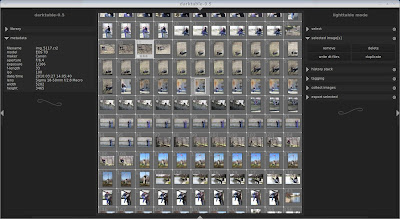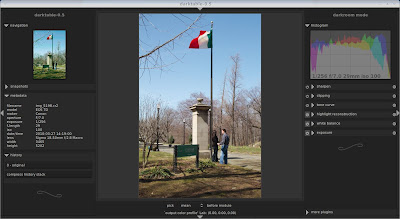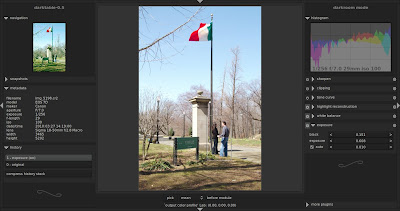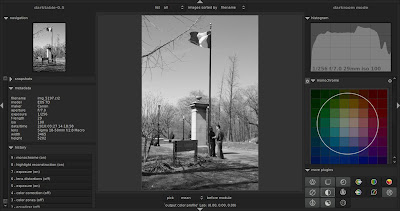What a great time. Enjoy this sneak preview!
Shannon and Sam's Engagement Session
Posted in engagement session, fusion montage, The Gorge Metro Park, video
This was my first experiment with some video clips during an engagement session. I hope you enjoy the results!
Congrats Shannon and Sam! I can't wait to shoot your wedding!
One of the strengths of linux is it's total flexibility. If there's one tool for the job, chances are there are another dozen that you don't know about yet. For ADD tinkerers such as myself, this blessing is also a curse! ;)
All that aside, recently I found Darktable. It's a RAW workflow software, based on the excellent DCRaw converter that is practically ubiquitous in linux, and even sneaks into more well known software (rumor has it that adobe based their raw conversion off of this as well).
At first glance, lightroom users will feel right at home. The dark interface, thumbnail view, and even the "end flourishes" look remarkably similar, and with good reason - it's a nice layout. Darktable has a nice feature called "zoomable light table", which basically allows you to drag the images around as if you were panning on an actual table. You can still scroll by using the "file manager" view (which is almost identical), but I'm impressed with the speed of the light table view.

of course, you can always zoom, re-order, filter, tag, group, etc. Both sidepanels (as well as the top and bottom panel) are collapsible, so you can use practically all of your screen for viewing. Nice touch.
Double clicking on an image brings you to the "Darkroom Mode". This is where all the heavy lifting is done.
 On the left, you see your navigation, snapshot, metadata, and history windows (all collapsible, of course). The right, your histogram and various "plugins". The creators of darktable really went out of their way to make sure there was no wasted space. The histogram is not only a display, but it allows you to adjust the exposure by simply clicking and dragging right on the histogram. Nice touch for quick adjustments.
On the left, you see your navigation, snapshot, metadata, and history windows (all collapsible, of course). The right, your histogram and various "plugins". The creators of darktable really went out of their way to make sure there was no wasted space. The histogram is not only a display, but it allows you to adjust the exposure by simply clicking and dragging right on the histogram. Nice touch for quick adjustments.Everything you'd expect in a RAW processor is there, and even some you may not expect. For example, one thing that really impressed me was the "Auto Exposure". Not that it had it, but the way it actually works. Take a look at this screen shot:

White balance is done in a similar fashion. You have the option of presets, or you can select an area. You're not just stuck with a small pixel area.
Monochrome is done very well, if not a bit different than other tools. You simply activate the Monochrome plugin (if you don't see it, go to "More plugins" at the bottom and click the icon), then you get this view:

by dragging the circle around the color palette, you can adjust your monochrome filter. Using the scroll wheel allows you to focus in on single colors (and makes the circle smaller) or to have a more balanced filter (thus making the circle larger). Very fast, very intuitive.
There are some oddities as well (to be expected for a version 0.5). You'll see a plugin called "clipping". Most photographers would think this means blown highlights or blocked up shadows, but they're actually talking about cropping. The "Equalizer" tool apparently is for noise reduction. When exporting, it doesn't tell you where the images will be (they're in a folder under your raws called "darktable_exported", btw). There's no cancel on the export, and for some reason on my system it set the initial quality of exported images to zero. (I can tell you, a zero quality level results in some very, very bad images....lol)
Of course, there are some things I'd like to see. The ability to work on multiple images at once, and presets are almost a requirement for anyone doing high volume work. The great part about open source software is the people that write it are real human beings, and actually respond to questions, suggestions, and emails. You have to love that!
Overall, I was very impressed with the speed which it responded. Very rarely was I waiting on the program to do anything. Many times with RAW conversion software, you are waiting on the software to re-convert the image when you make adjustments - not so with darktable. It was always quick and snappy to respond to even the most complex adjustments. The interface was easily on par with the commercial software I use, Bibble5. It's not on the same level as bibble in many aspects (conversion speed, workflow speed, noise removal, among other things) but it does very well, and has the potential for great improvement. I'll be watching it closely!
You can download darktable from their website: http://darktable.sourceforge.net/
Ubuntu users can install with the software center by adding Pascal deBruin's ppa: ppa:pmjdebruijn/ppa
Until next time!
Shan
Archives
Contributors

- Shannon Smith, 831 Photography
- Akron, OH, United States
- Photographer, Trainer, Geek. Don't even get me started about lighting techniques!
Categories
- 831 photography engagement session chicago il fun photo
- Adobe
- Akron Civic Theatre
- Akron OH
- album design
- albums WPPI 2007 convention rock-it banners products la-vie asuka coffee table
- alien bees
- Anthe's Event Center
- babies first year
- Bat Mitzvah
- Beach Wedding
- bh photo shopping nyc lenses
- bibble pro digital workflow raw processing
- birthday party
- Bob Davis
- British Virgin Islands
- business practices digital negatives
- BVI
- Canon 40D sample images high ISO
- canon 5d replacement destined evolution teaser marketing enigma
- Chenoweth Country Club Green Valley United Methodist Church outdoor portraits
- children
- cleaning the house friends visiting personal
- collage
- content aware fill
- contest winner northeast ohio
- country
- CS5
- customer gtg
- Cuyahoga Falls Riverfront
- dairy barn reception
- democrats
- destination
- destination wedding
- DeYor Theatre
- Disney Vacation personal Thunderbird Air Force Epcot rain
- engagement session
- engagement session video 831 photography camera shy
- Ernest Perry
- Event Planner
- eyes
- family
- farm
- february
- firefighter wedding
- flashwaves
- foss
- fruity marshmallows
- fun stuff
- funny
- funny first dance video
- fusion montage
- geek quiz
- Get together
- gimp
- glamour
- goals wppi speaker convention dreams deadlines
- good days
- GTG
- guest blog post
- Guy's Party Center Akron
- hand raised butterflies Lake Forest Country Club Hudson
- happy thanksgiving
- hard light
- hawaii
- henna mehendi ceremony Maya Anjum artist hindu indian wedding traditions
- hi
- hollywood
- How It's Made comments
- humor
- ice skating
- initial impressions
- inspiration
- introduction
- intuit
- Jenny
- Joe
- Kenny Kim
- kids
- kubuntu
- lake anna barberton
- las vegas
- legend
- lightroom replacement
- linux
- Long Bay Resort
- LW Special Events
- mark nancy wedding
- Master Your Craft
- maui
- mccain
- Mike Colón
- monte zucker
- morgan eric wedding marti stutzman 32 ford getaway car fun formals
- mpix
- Mr Anthonys
- New York
- New York City
- newborn
- no class holiday enjoy your family
- no mac no cheese
- no mac no cheese digital photography back button focusing canon 40d vertical grip af-on button * button ae lock button swap
- no mac no cheese digital photography canon 40d af point auto focus selection method quick controller thumb wheel finger wheel custom function
- no mac no cheese digital photography canon cp-e3 battery pack flash recycle time rechargable batteries
- no mac no cheese digital photography conference mpix video
- no mac no cheese digital photography dragging the shutter high iso av mode aperture priority mode
- no mac no cheese digital photography fluorescent light color shift white balance shutter speed frequency
- no mac no cheese digital photography google reader subscribers [b] school blog comparison [b]ecker honored humbled stunned
- no mac no cheese digital photography hard drive backups
- no mac no cheese digital photography high speed sync outdoor portraits av mode aperture priority
- no mac no cheese digital photography how-to canon 40d menu settings
- no mac no cheese digital photography how-to flash diffuser lightsphere
- no mac no cheese digital photography how-to hard light umbra penumbra contrast rembrandt lighting classic technique one light
- no mac no cheese digital photography how-to location background distractions
- no mac no cheese digital photography lightning thunderstorm daytime nighttime bulb mode images
- no mac no cheese digital photography macro close up photography extension tubes shallow depth of field
- no mac no cheese digital photography mirror lock up reduce shake
- no mac no cheese digital photography optimal lens sharpness aperture depth of field stopping down
- no mac no cheese digital photography photoshop
- no mac no cheese digital photography photoshop grunge effect texture blending modes
- no mac no cheese digital photography single light hard light source shading angle off-camera
- no mac no cheese digital photography soft light diffuse umbrella contrast control light falloff
- no mac no cheese digital photography tutorials high iso grain vs blur motion blur noise
- no mac no cheese digital photography tutorials tv mode shutter priority motion blur waterfall
- no mac no cheese digital photography tutorials using a tripod
- no mac no cheese digital photography vertical grip problems how to fix
- no mac no cheese digital photography white balance cap custom white balance generic expodisk
- no mac no cheese digital photography wppi competition print
- no mac no cheese episode tutorials digital how-to photography
- no mac no cheese episode tutorials digital how-to photography back button focus
- no mac no cheese episode tutorials digital how-to photography backgrounds location
- no mac no cheese episode tutorials digital how-to photography battery pack al jacobs vivitar flash
- no mac no cheese episode tutorials digital how-to photography contrast control fill flash blue sky outdoor photography
- no mac no cheese episode tutorials digital how-to photography cropping aspect ratio
- no mac no cheese episode tutorials digital how-to photography custom white balance 40d mixed lighting
- no mac no cheese episode tutorials digital how-to photography faststone image viewer sort select images software
- no mac no cheese episode tutorials digital how-to photography flash bounced foofing directional light
- no mac no cheese episode tutorials digital how-to photography flash gel color balance
- no mac no cheese episode tutorials digital how-to photography getting ready for a wedding
- no mac no cheese episode tutorials digital how-to photography google picasa
- no mac no cheese episode tutorials digital how-to photography low light slow shutter handheld
- no mac no cheese episode tutorials digital how-to photography overcast day flash kick light direction pop
- no mac no cheese episode tutorials digital how-to photography photoshop create an action
- no mac no cheese episode tutorials digital how-to photography vivitar flash 285HV automatic mode
- no mac no cheese episode tutorials digital how-to photography white balance
- no mac no cheese episode tutorials digital how-to vivitar 285 hv broken foot replacement
- no mac no cheese premier episode tutorials digital how-to photography
- no mac no cheese snow day
- no mac no cheese tutorials business custom framing
- no mac no cheese tutorials digital photography FTP software filezilla how-to website upload
- no mac no cheese will return after a short break
- NYC
- NYC New York Macy's Santa Santaland kids natural light 50mm
- obama
- off camera flash
- OH
- OH Our Lady of Perpetual Help Aurora
- OH slideshow
- OH slideshow dollar dance cake auction
- open source
- os discrimination
- Pentax Optio W30 underwater camera
- personal
- personal attempted boating trip murphy's law
- personal class digital photography training no mac no cheese wedding portrait general second shooter
- personal touches
- personalized wedding
- photographer
- photography
- Picasa 3.6
- politics
- print competition
- quickbooks
- radio slaves
- radio triggers
- random post
- raw workflow
- recent work guys party center Trinity Mission Baptist Church Akron
- reflector
- remodeling framing in home consultations decorating fine art
- remote flash
- republicans
- responsibility
- resynthesizer
- review
- sailboat
- Second Baptist Church
- senior portraits
- Sheraton
- sick forums mpix cruise
- Silverlake Country Club
- St Louis Church of Louisville
- Stacey Adams
- Stacy Al wedding holiday weekend
- Stamford CT
- Stamford Yacht Club
- Stan Hwyett
- studio
- stupidity
- teacher
- technology
- the galaxy restaurant
- The Gorge Metro Park
- the happy dance
- the nerd husband
- Tortola
- Tortola BVI destination wedding cliffs exploring photography
- tortola BVI fun sailboat snorkeling underwater photography BVI
- Tortola BVI fun sea cliffs waves breakers
- tortola destination wedding BVI island beach photography
- triggers
- tutorials photoshop DPI high resolution
- ubuntu
- video
- vivitar
- vivitar workshop
- Washington DC destination engagement session sunset monuments night portrait sigma 24-70 2.8 50-150 2.8 travel
- website hacked backup local
- wedding
- wedding brad melissa Raintree Country Club Portage Lakes
- Wedding Pictures
- wedding reception lighting hollywood style
- wedding slideshow
- wedding stop motion video linux slideshow
- wedding wadsworth united methodist church
- workflow
- workshop
- wppi
- WPPI 2007 passion Carl Caylor
- WPPI 2008 club rouge party speakers boudoir
- wppi mpix presenting Las Vegas
- Youngstown OH